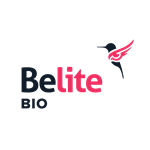- LBS-008 (aka Tinlarebant) was safe and well tolerated in adolescent Stargardt Disease (STGD1) subjects at 12-month time point
- The majority of the subjects showed stabilization of BCVA in at least one eye
- A trend for preventing or slowing expansion of autofluorescence continue to be observed
- No atrophic lesion (DDAF) in 12 of 13 subjects at the 12-month treatment period
- 12-month interim data from the ongoing Phase 2 study continue to show stabilization in several parameters, including halting or slowing lesion growth, preservation in retinal thickness, reduction in Ellipsoid Zone (EZ) defect width, and stabilization of visual acuity.
SAN DIEGO, Oct. 01, 2022 (GLOBE NEWSWIRE) -- Belite Bio, Inc (NASDAQ: BLTE), a San Diego based clinical stage biopharmaceutical drug development company targeting currently untreatable eye diseases, today presented one-year data from their ongoing two-year Phase 2 clinical study of Tinlarebant in STGD1 as part of the oral presentation series at the Annual Meeting of the American Academy of Ophthalmology (AAO) held during September 30 - October 3, 2022 at McCormick Place, Chicago.
“We are glad that Tinlarebant’s Phase 2 results were presented in a late-breaking oral session at the AAO annual meeting.” said Dr. Tom Lin, Belite Bio’s Chairman and CEO. “The Phase 2 data presented at AAO continue to support Tinlarebant’s safety and efficacy profile over the one-year treatment period and reinforce that this investigational therapy is a promising oral treatment for STGD1 patients.”
Professor John Grigg, the study’s principal investigator and Head Specialty of Ophthalmology at the University of Sydney and Consultant Ophthalmologist at the Sydney Children’s Hospitals Network at Westmead and Sydney Eye Hospital provided a presentation of the interim study data.
To date, all 13 patients have completed one-year of treatment in the ongoing two-year Phase 2 study of Tinlarebant. The results for safety and tolerability assessments, and retinal imaging data have been collected for the evaluation of disease progression. Images from spectral-domain optical coherence tomography imaging, an imaging modality that permits visualization of the retinal anatomy, have shown a stabilization of retinal thickness in many subjects. Fundus autofluorescence imaging shows no autofluorescence expansion (QDAF) in 7 of 13 (53.8%) subjects, and 12 of 13 (92.3%) subjects also show no atrophic lesion (DDAF) after one year of treatment. More importantly, 9 of 13 (69.2%) subjects show a stabilization or improvement in visual acuity throughout the one-year treatment period. A copy of the presentation slides is available at https://investors.belitebio.com/aao-presentation-download-form.
According to the international prospective study of STGD1 (the ProgStar Study), childhood-onset patients with no atrophic lesion (DDAF) at baseline experienced an average lesion growth rate of 0.66 mm2 for the left eyes and 0.74 mm2 for the right eyes at one year. In addition, the Prospective Cohort Study of Childhood-Onset Stargardt Disease by Georgiou et al. reported an average atrophic lesion growth rate (DDAF) of 0.69 mm2/year for children. Belite Bio’s one-year data from ongoing Phase 2 study showed an average lesion growth rate of 0.03 mm2/year, demonstrating a promising trend toward halting or slowing the disease progression in the study cohort.
“We are very encouraged by the 12-month treatment results from our Phase 2 Study. While the natural progression of childhood-onset STGD1 is characterized by a rapid visual decline and fast disease progression leading to permanent visual loss at a very young age, the Phase 2 interim data have shown the stabilization in several structural and functional parameters.” said Dr. Tom Lin.
Belite Bio is currently conducting a two-year Phase 2 study and a two-year Phase 3 study (DRAGON) of Tinlarebant in adolescent STGD1 subjects. Belite Bio expects the next data readout in its Phase 2 STGD1 study to occur during the second quarter of 2023 when all subjects will complete 18 months of treatment.
About DRAGON Study
The two-year Phase 3 study named DRAGON is a Multi-Center, Randomized, Double-Masked, Placebo-Controlled Study to Evaluate the Safety and Efficacy of TinlaRebant in the Treatment of StArGardt Disease in AdOlesceNt Subjects. DRAGON study is designed to evaluate the safety and efficacy of Tinlarebant in adolescent STGD1 patients. To date, Belite Bio has commenced the Phase 3 study in the U.S., the United Kingdom, Germany, Belgium, Switzerland, Hong Kong, Taiwan, mainland China and Australia. Approximately 60 patients are targeted for enrollment in this study with a 2:1 randomization (active:placebo). For more information, visit clinicaltrials.gov at https://www.clinicaltrials.gov/ct2/show/NCT05244304?term=belite+bio&draw=2&rank=1)
About LBS-008 (aka Tinlarebant)
Tinlarebant is a novel oral therapy that prevents the buildup of toxins in the eye that cause STGD1 and contribute to advanced dry AMD. These toxins are by-products of the visual cycle, which is dependent on the supply of vitamin A (retinol) to the eye. Tinlarebant works by reducing and maintaining levels of serum retinol binding protein 4 (RBP4), a carrier protein that transports retinol to the eye. By modulating the amount of retinol entering the eye, Tinlarebant reduces the formation of toxins that have been implicated in STGD1 and dry AMD. Tinlarebant has been granted Fast Track Designation and Rare Pediatric Disease designation in the U.S., and Orphan Drug Designation in the U.S. and Europe for the treatment of STGD1.
Stargardt Disease
STGD1 is the most common inherited retinal dystrophy (causing blurring or loss of central vision) in both adults and children. The disease is caused by a dysfunctional retina-specific gene (ABCA4) which results in massive accumulation of toxic vitamin A byproducts (known as “bisretinoids”) in the retina leading to retinal cell death and progressive loss of central vision. The fluorescent properties of bisretinoids and the development of retinal imaging have helped ophthalmologists identify and monitor disease progression. Importantly, STGD1 and dry AMD share a similar pathophysiology which is characterized by the excessive accumulation of cytotoxic bisretinoids, retinal cell death, and loss of vision. Vision loss occurs slowly, despite peripheral expansion of “dead retina”, until the disease reaches the center of the eye (the macula).
Dry Age-related Macular Degeneration
Dry AMD is a leading cause of vision loss in the U.S. and has no approved treatments available. There are an estimated 11 million dry AMD patients in the U.S. and over 196 million patients worldwide with an estimated global direct healthcare cost of US$255 billion.
About Belite Bio
Belite Bio is a San Diego based clinical stage biopharmaceutical drug development company targeting currently untreatable eye diseases, such as atrophic age-related macular degeneration (commonly known as dry AMD) and STGD1, in
addition to specific metabolic diseases. For more information, follow us on Twitter, Instagram, LinkedIn, Facebook or visit us at www.belitebio.com.
Important Cautions Regarding Forward Looking Statements
This press release contains forward-looking statements, including statements regarding the potential implications of clinical data for patients, and Belite Bio’s advancement of, and anticipated preclinical activities, clinical development, regulatory milestones, and commercialization of its product candidates. Actual results may differ materially from those indicated in the forward-looking statements as a result of various important factors, including but not limited to Belite Bio’s ability to demonstrate the safety and efficacy of its drug candidates; the clinical results for its drug candidates, which may not support further development or regulatory approval; the content and timing of decisions made by the relevant regulatory authorities regarding regulatory approval of Belite Bio’s drug candidates; the potential efficacy of Tinlarebant on the treatment of Dry AMD, as well as those risks more fully discussed in the “Risk Factors” section in Belite Bio’s filings with the U.S. Securities and Exchange Commission. All forward-looking statements are based on information currently available to Belite Bio, and Belite Bio undertakes no obligation to publicly update or revise any forward-looking statements, whether as a result of new information, future events or otherwise, except as may be required by law.
Media and Investor Relations Contact:
Jennifer Wu /ir@belitebio.com
Tim McCarthy /tim@lifesciadvisors.com








